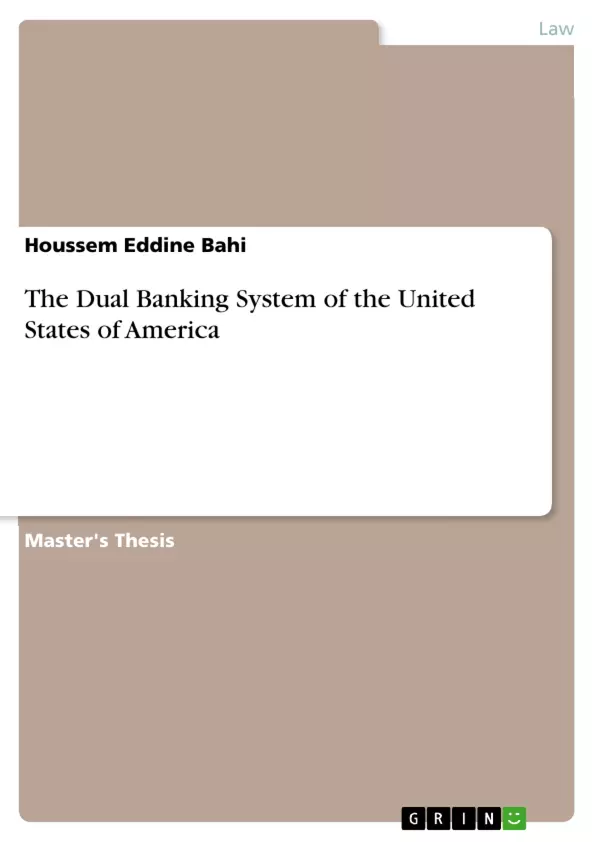
The Dual Banking System of the United States of America
Masterarbeit, 2015
129 Seiten
Leseprobe
Table of Contents
- Part 1: Foundation of the Dual Banking System
- Chapter 1: Origins of Dual Banking System
- Section 1: National Banking Experiences
- Section 2: Effects of Federal Reserve Act on Banking
- Chapter 2: Dual Banking Specificities
- Section 1: Banking Regulators
- Section 2: Banking Activities within the United States
- Part 2: The Soul of Duality
- Chapter 1: Accompanying Banks within Duality
- Section 1: Banks Chartering
- Section 2: Supervision and Control
- Chapter 2: Duality Between Internal Synergies and External Joints
- Section 1: Duality Issues
- Section 2: Preventive Measures to the Success of US Banking
Objectives and Key Themes
This dissertation aims to explore the dual banking system in the United States of America. It examines the historical development, specific characteristics, and challenges of this system.
- Origins and historical development of the dual banking system.
- The roles and responsibilities of different banking regulators.
- Specific activities permitted within the US dual banking framework.
- The interplay between internal bank synergies and external regulatory connections.
- Challenges and preventive measures related to the success and stability of the US banking system.
Chapter Summaries
Part 1: Foundation of the Dual Banking System: This section lays the groundwork for understanding the dual banking system by exploring its historical origins and key characteristics. It delves into the national banking experiences that shaped the system, analyzing the impact of significant legislation such as the Federal Reserve Act. Furthermore, it details the specific roles of various banking regulators and the types of banking activities permitted under this framework within the United States. The part establishes a foundation for understanding the complexities and nuances of the dual system before delving into a deeper analysis of its operational aspects in Part 2.
Chapter 1: Origins of Dual Banking System: This chapter explores the historical evolution of the dual banking system in the USA. It examines the national banking experiences that preceded the establishment of the dual system, providing context for its development. The chapter also analyzes the significant impact of the Federal Reserve Act on the structure and function of the banking system, showing how it interacted with pre-existing state-chartered banks, creating the dual system we know today. The effects are discussed in terms of regulation, oversight and the overall landscape of American banking.
Chapter 2: Dual Banking Specificities: This chapter focuses on the unique characteristics of the dual banking system. It examines the roles and responsibilities of various banking regulators, highlighting the division of authority between federal and state-level entities. The chapter also delves into the types of banking activities permitted under the dual system, contrasting and comparing state and federally chartered banks. By examining regulatory differences and their impact on banking activities, it provides a clear picture of the system's structure and function, laying the groundwork for exploring the complexities of the dual system's operation.
Part 2: The Soul of Duality: This section delves into the dynamics and intricacies of the dual banking system, exploring the interactions between different banking entities and the measures taken to ensure stability. It investigates the challenges inherent within the dual system, and analyses the preventive measures put in place to mitigate risks and foster success.
Chapter 1: Accompanying Banks within Duality: This chapter analyzes the processes of bank chartering within the dual banking system, comparing and contrasting the procedures for obtaining federal and state charters. It then examines the supervisory and control mechanisms employed by the different regulatory bodies, emphasizing the complexities and potential conflicts that can arise from having two distinct levels of oversight. The examination considers how the dual structure impacts the effectiveness of regulatory control and the implications for bank stability.
Chapter 2: Duality Between Internal Synergies and External Joints: This chapter explores the inherent tensions and synergies within the dual banking system. It analyzes various challenges posed by the dual structure, potentially including conflicts of interest, regulatory arbitrage, and systemic risk. The chapter then turns to the preventive measures implemented to mitigate these risks and foster the overall success and stability of the US banking system. This could involve discussion of specific regulations, supervisory practices, and cooperative efforts between federal and state regulators.
Keywords
Dual banking system, United States, banking regulation, Federal Reserve, state banking, bank chartering, supervision, regulatory oversight, financial stability, systemic risk, preventive measures.
Frequently Asked Questions: A Comprehensive Language Preview of the Dual Banking System in the USA
What is the overall focus of this document?
This document provides a comprehensive preview of a dissertation exploring the dual banking system in the United States. It includes a table of contents, objectives and key themes, chapter summaries, and keywords.
What are the main parts of the dissertation previewed here?
The preview is divided into two main parts: Part 1, "Foundation of the Dual Banking System," and Part 2, "The Soul of Duality." Each part contains chapters focusing on different aspects of the dual banking system.
What topics are covered in Part 1: Foundation of the Dual Banking System?
Part 1 explores the historical origins of the dual banking system, tracing its development through national banking experiences and the impact of the Federal Reserve Act. It also details the roles of various banking regulators and the specific banking activities permitted within the US framework.
What are the key themes discussed in Chapter 1 of Part 1?
Chapter 1, "Origins of Dual Banking System," examines the historical evolution of the dual system in the USA, including the national banking experiences that preceded it and the significant impact of the Federal Reserve Act on its structure and function.
What are the key themes discussed in Chapter 2 of Part 1?
Chapter 2, "Dual Banking Specificities," focuses on the unique characteristics of the dual banking system, including the roles of banking regulators (both federal and state) and the types of banking activities permitted under the system for state and federally chartered banks.
What topics are covered in Part 2: The Soul of Duality?
Part 2 delves into the dynamics and intricacies of the dual banking system, exploring the interactions between different banking entities and the measures taken to ensure stability. It investigates the challenges inherent within the dual system and analyzes preventive measures to mitigate risks.
What are the key themes discussed in Chapter 1 of Part 2?
Chapter 1, "Accompanying Banks within Duality," analyzes bank chartering processes within the dual system, comparing federal and state charters, and examines supervisory and control mechanisms employed by different regulatory bodies, highlighting potential conflicts.
What are the key themes discussed in Chapter 2 of Part 2?
Chapter 2, "Duality Between Internal Synergies and External Joints," explores the tensions and synergies within the dual banking system, analyzing challenges such as conflicts of interest and systemic risk. It also discusses preventive measures implemented to ensure the success and stability of the US banking system.
What are the key objectives of the dissertation?
The dissertation aims to explore the dual banking system in the USA, examining its historical development, specific characteristics, and challenges. This includes analyzing the roles of banking regulators, permitted banking activities, the interplay between internal bank synergies and external regulatory connections, and preventive measures for system stability.
What are the key words associated with this dissertation?
Key words include: Dual banking system, United States, banking regulation, Federal Reserve, state banking, bank chartering, supervision, regulatory oversight, financial stability, systemic risk, and preventive measures.
Where can I find a detailed table of contents?
The provided document includes a detailed table of contents outlining the structure of the dissertation, broken down into parts and chapters with sections.
What is the purpose of the chapter summaries provided?
The chapter summaries offer concise overviews of the key themes and arguments presented in each chapter of the dissertation, providing a clear understanding of the content before engaging with the full text.
Details
- Titel
- The Dual Banking System of the United States of America
- Hochschule
- University of Carthage (Faculty of Legal, Political and Social Sciences)
- Veranstaltung
- Common Law
- Autor
- Houssem Eddine Bahi (Autor:in)
- Erscheinungsjahr
- 2015
- Seiten
- 129
- Katalognummer
- V316375
- ISBN (eBook)
- 9783668152946
- ISBN (Buch)
- 9783668152953
- Dateigröße
- 1563 KB
- Sprache
- Englisch
- Schlagworte
- usa dual banking system
- Produktsicherheit
- GRIN Publishing GmbH
- Preis (Ebook)
- US$ 40,99
- Preis (Book)
- US$ 52,99
- Arbeit zitieren
- Houssem Eddine Bahi (Autor:in), 2015, The Dual Banking System of the United States of America, München, Page::Imprint:: GRINVerlagOHG, https://www.diplomarbeiten24.de/document/316375
- Autor werden
- Ihre Optionen
- Vertriebskanäle
- Premium Services
- Autorenprofil
- Textarten und Formate
- Services für Verlage, Hochschulen, Unternehmen

- © GRIN Publishing GmbH.
- Alle Inhalte urheberrechtlich geschützt. Kopieren und verbreiten untersagt.
- info@grin.com
- AGB
- Open Publishing
Der GRIN Verlag hat sich seit 1998 auf die Veröffentlichung akademischer eBooks und Bücher spezialisiert. Der GRIN Verlag steht damit als erstes Unternehmen für User Generated Quality Content. Die Verlagsseiten GRIN.com, Hausarbeiten.de und Diplomarbeiten24 bieten für Hochschullehrer, Absolventen und Studenten die ideale Plattform, wissenschaftliche Texte wie Hausarbeiten, Referate, Bachelorarbeiten, Masterarbeiten, Diplomarbeiten, Dissertationen und wissenschaftliche Aufsätze einem breiten Publikum zu präsentieren.
Kostenfreie Veröffentlichung: Hausarbeit, Bachelorarbeit, Diplomarbeit, Dissertation, Masterarbeit, Interpretation oder Referat jetzt veröffentlichen!
- GRIN Verlag GmbH
-
- Nymphenburger Str. 86
- 80636
- Munich, Deutschland
- +49 89-550559-0
- +49 89-550559-10
- info@grin.com
-









